
The Steyr AUG is an Austrian bullpup assault rifle chambered for the 5.56×45mm NATO intermediate cartridge, designed in the 1960s by Steyr-Daimler-Puch, and now manufactured by Steyr Arms GmbH & Co KG.
Thales S.A., trading as Thales Group is a French multinational corporation specialized in the design, development, manufacturing and support of electronic systems as well as devices and equipment for the aerospace, defence, security and transportation sectors. The company is headquartered in Paris' business district, La Défense, and its stock is listed on Euronext Paris.

The Dassault Mirage F1 is a French fighter and attack aircraft designed and manufactured by Dassault Aviation. It was developed as a successor to the Mirage III family.

The Dassault Mirage 2000 is a French multirole, single-engine, delta wing, fourth-generation jet fighter manufactured by Dassault Aviation. It was designed in the late 1970s as a lightweight fighter to replace the Mirage III for the French Air Force. The Mirage 2000 evolved into a multirole aircraft with several variants developed, with sales to a number of nations. It was later developed into the Mirage 2000N and 2000D strike variants, the improved Mirage 2000-5, and several export variants. Over 600 aircraft were built and it has been in service with nine nations.

The Royal Danish Air Force (RDAF) is the aerial warfare force of the Kingdom of Denmark and one of the four branches of the Danish Armed Forces. Initially being components of the Army and the Navy, it was made a separate service in 1950. Its main purpose is to serve as enforcer of Danish airspace and to provide air support to Danish group troops on the battlefield.

The Dassault Mirage 2000N is a variant of the Mirage 2000 designed for nuclear strike. It formed the core of the French air-based strategic nuclear deterrent. The Mirage 2000D is its conventional attack counterpart. Although it looks like a Mirage 2000 trainer, it was actually used as a fighter-attack aircraft.
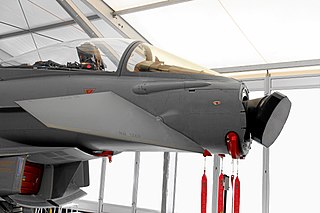
An active electronically scanned array (AESA) is a type of phased array antenna, which is a computer-controlled antenna array in which the beam of radio waves can be electronically steered to point in different directions without moving the antenna. In the AESA, each antenna element is connected to a small solid-state transmit/receive module (TRM) under the control of a computer, which performs the functions of a transmitter and/or receiver for the antenna. This contrasts with a passive electronically scanned array (PESA), in which all the antenna elements are connected to a single transmitter and/or receiver through phase shifters under the control of the computer. AESA's main use is in radar, and these are known as active phased array radar (APAR).
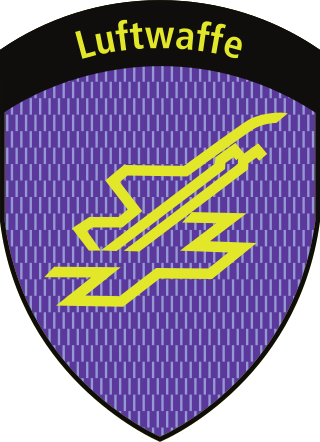
The Swiss Air Force is the air component of the Swiss Armed Forces, established on 31 July 1914, three days after the outbreak of World War I, as a part of the army and in October 1936 as an independent service.

The S-125 Neva/Pechora is a Soviet surface-to-air missile system that was designed by Aleksei Isaev to complement the S-25 and S-75. It has a shorter effective range and lower engagement altitude than either of its predecessors and also flies slower, but due to its two-stage design it is more effective against more maneuverable targets. It is also able to engage lower flying targets than the previous systems, and being more modern it is much more resistant to ECM than the S-75. The 5V24 (V-600) missiles reach around Mach 3 to 3.5 in flight, both stages powered by solid fuel rocket motors. The S-125, like the S-75, uses radio command guidance. The naval version of this system has the NATO reporting name SA-N-1 Goa and original designation M-1 Volna.

The Sukhoi Su-30MKM is a twin-engine supermaneuverable fighter of the Royal Malaysian Air Force (RMAF). It is a variant of the Su-30 series fighters, with many significant improvements over the original Su-30MK export version. The Su-30MKM was developed by the Sukhoi Design Bureau and is based on the Su-30MKI of the Indian Air Force. Both aircraft have common airframe, thrust vectoring engines and a digital fly-by-wire system, however the MKM version differs from the MKI mainly in the composition of the onboard avionics. It can carry up to 8,000 kg (17,637 lb) payload over a 1,296 km un-refueled combat radius.
Radar Doppler Multitarget is a multimode Look-down/shoot-down Pulse-Doppler radar designed by Thomson-CSF for the Mirage 2000-5 fighter. The RDY-3 derivative has been fitted to Moroccan Mirage F1s. Thomson has claimed that the original RDY outperformed the AN/APG-66/68 of the F-16 and the AN/APG-65 of the F/A-18 Hornet.
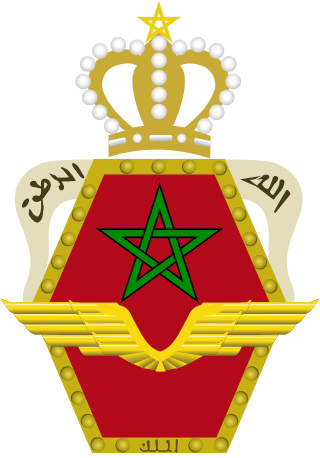
The Royal Moroccan Air Force is the air force of the Moroccan Armed Forces.
Thales-Raytheon Systems Company LLC is an aerospace and defence company co-headquartered in Massy, Paris, France and Fullerton, California, United States. It is operated as a 50:50 joint venture between Raytheon Technologies and Thales Group.

The AN/PRC-148 Multiband Inter/Intra Team Radio (MBITR) is the most widely fielded handheld multiband, tactical software-defined radio, used by NATO forces around the world. The radio is built by Thales Communications, a subsidiary of the France-based Thales Group. The designation AN/PRC translates to Army/Navy Portable Radio used for two-way communications, according to Joint Electronics Type Designation System (JETDS) guidelines.

The United Arab Emirates Air Force (UAEAF) is the air force of the United Arab Emirates (UAE), part of the United Arab Emirates Armed Forces. Its predecessor was established in 1968, when the Emirates were still under British rule. Since then, it has undergone a continual reorganisation and expansion in terms of both capability and numbers of aircraft. Currently, the UAEAF has around 4,000 personnel and operates approximately 560 fixed wing and rotorcraft.
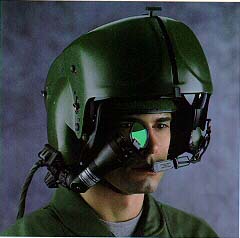
A helmet-mounted display (HMD) is a headworn device that uses displays and optics to project imagery and/or symbology to the eyes. It provides visual information to the user where head protection is required – most notably in military aircraft. The display-optics assembly can be attached to a helmet or integrated into the design of the helmet. An HMD provides the pilot with situation awareness, an enhanced image of the scene, and in military applications cue weapons systems, to the direction their head is pointing. Applications which allow cuing of weapon systems are referred to as helmet-mounted sight and display (HMSD) or helmet-mounted sights (HMS).

The Dassault Rafale is a French twin-engine, canard delta wing, multirole fighter aircraft designed and built by Dassault Aviation. Equipped with a wide range of weapons, the Rafale is intended to perform air supremacy, interdiction, aerial reconnaissance, ground support, in-depth strike, anti-ship strike and nuclear deterrence missions. It is referred to as an "omnirole" 4.5th generation aircraft by Dassault.

The Hawkei is an Australian light four-wheel-drive protected mobility vehicle. Originally designed in 2010 to meet an Australian Defence Force (ADF) requirement for a light armoured patrol vehicle to replace some of its Land Rover Perentie variants. The Hawkei is a highly mobile, highly protected, 7-tonne vehicle, with inbuilt systems to allow it to be used as a fighting platform. It has been developed with Vehicle Electronic Architecture to be mission system ready.

Multi Calibre Individual Weapon System (MCIWS) is an assault rifle developed in India by the Armament Research and Development Establishment, a laboratory of the Defence Research and Development Organisation. It was first seen at the DEFEXPO 2014 exhibition.
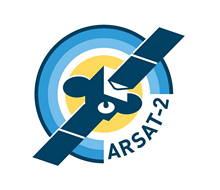
ARSAT-2 is a geostationary communications satellite operated by ARSAT and built by the Argentine company INVAP. It was launched from French Guiana alongside Sky Muster satellite using an Ariane 5ECA rocket on September 30, 2015 at 20:30hs UTC, becoming the 400th satellite to be launched by Arianespace. It is licensed to be located at 81° West longitude geostationary slot. ARSAT-2 is the second geostationary satellite built in Argentina, after ARSAT-1. Structurally and mechanically it is a copy of the ARSAT-1, the only difference being the payload and thus it has different antenna configuration.

















